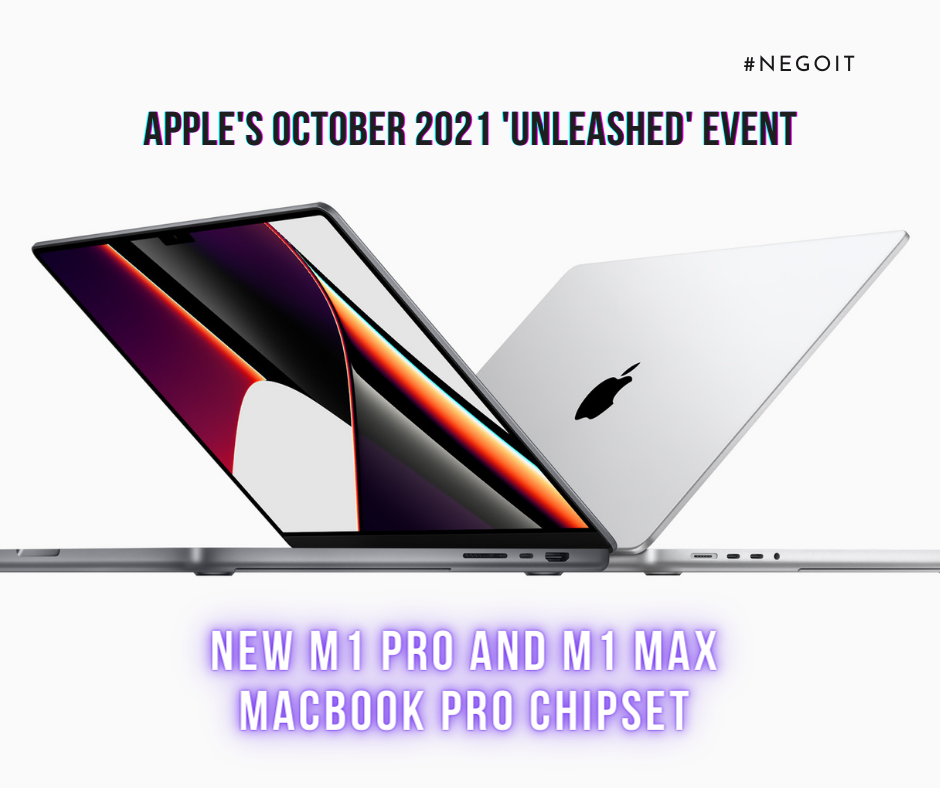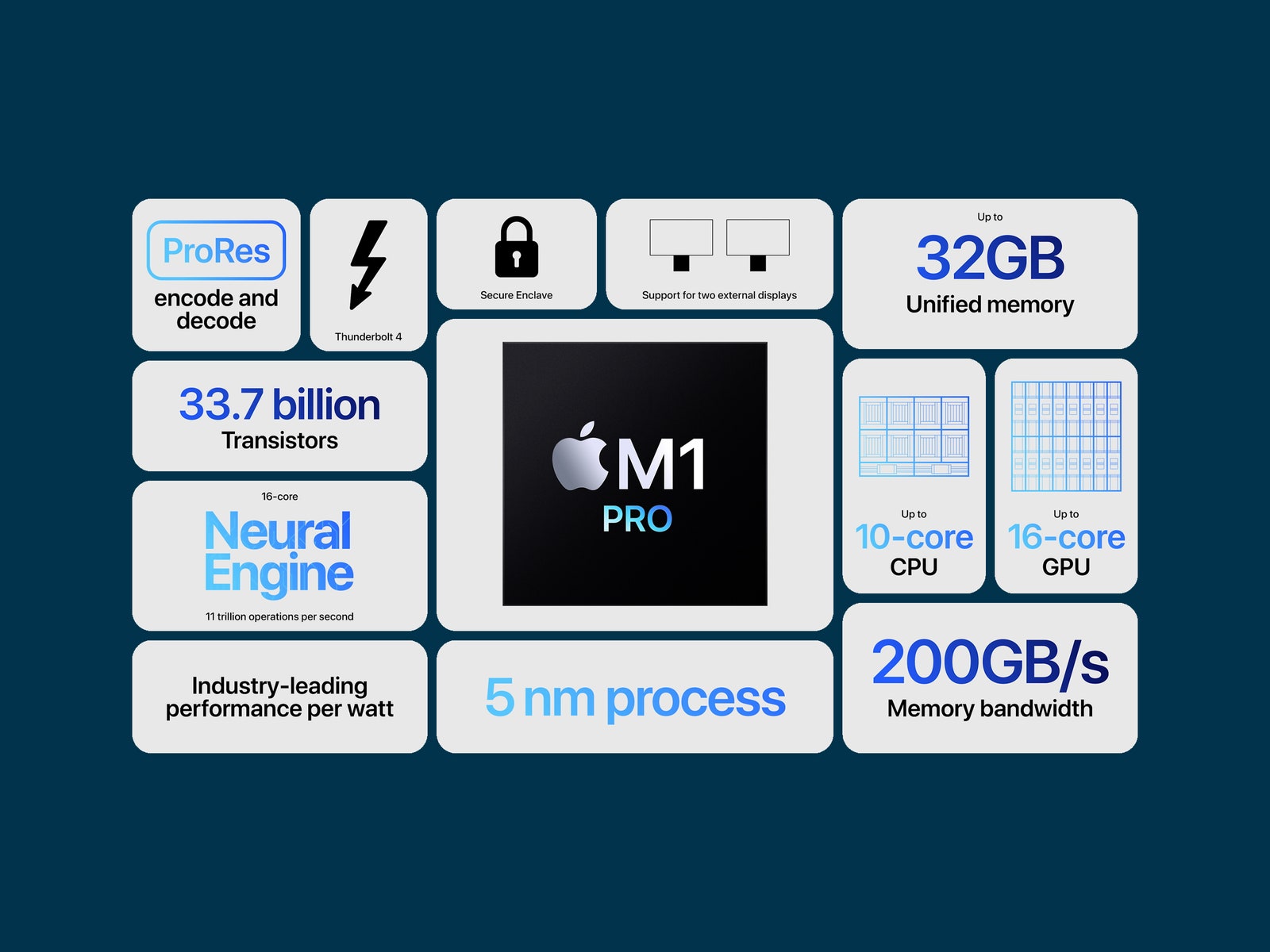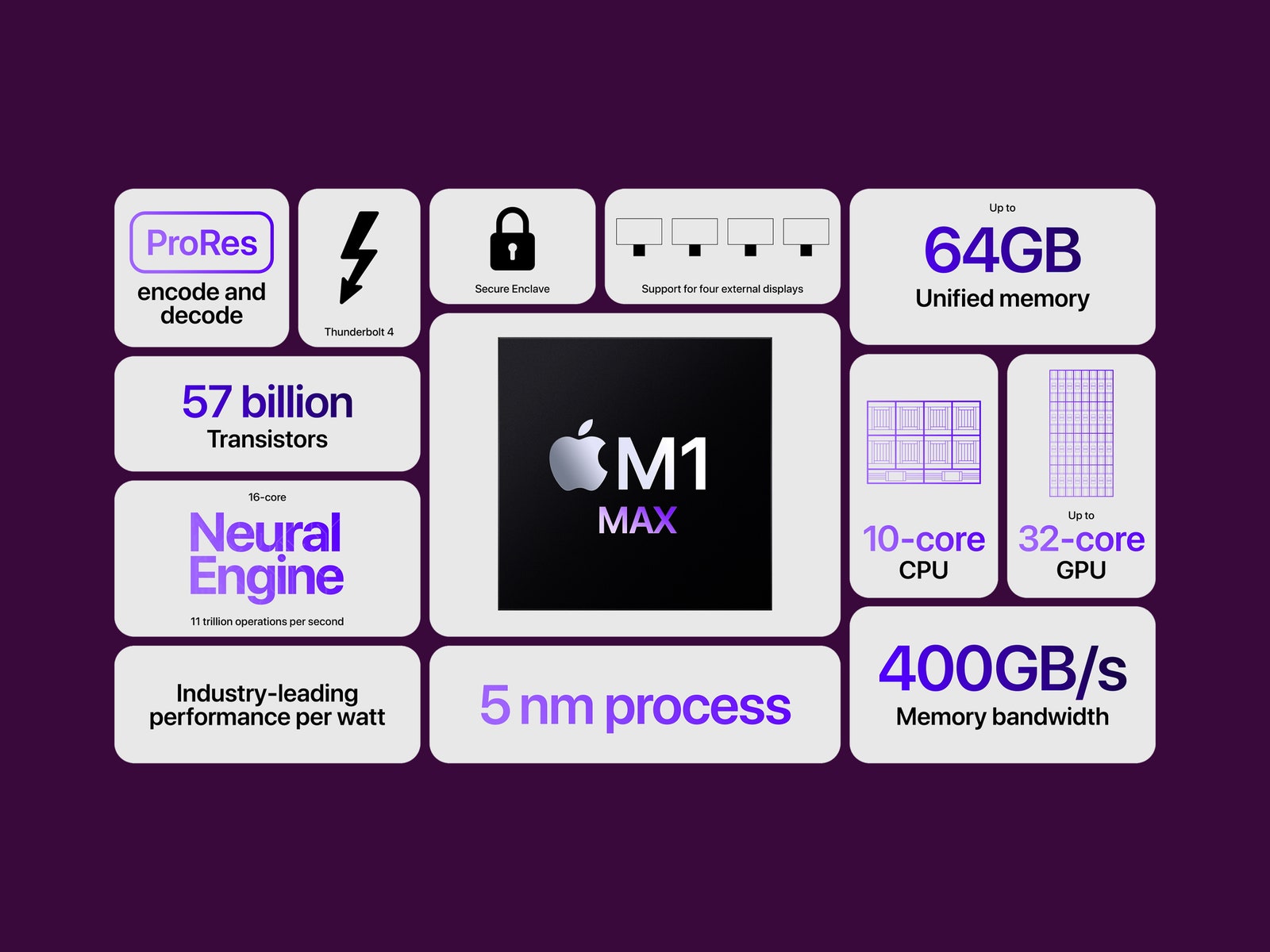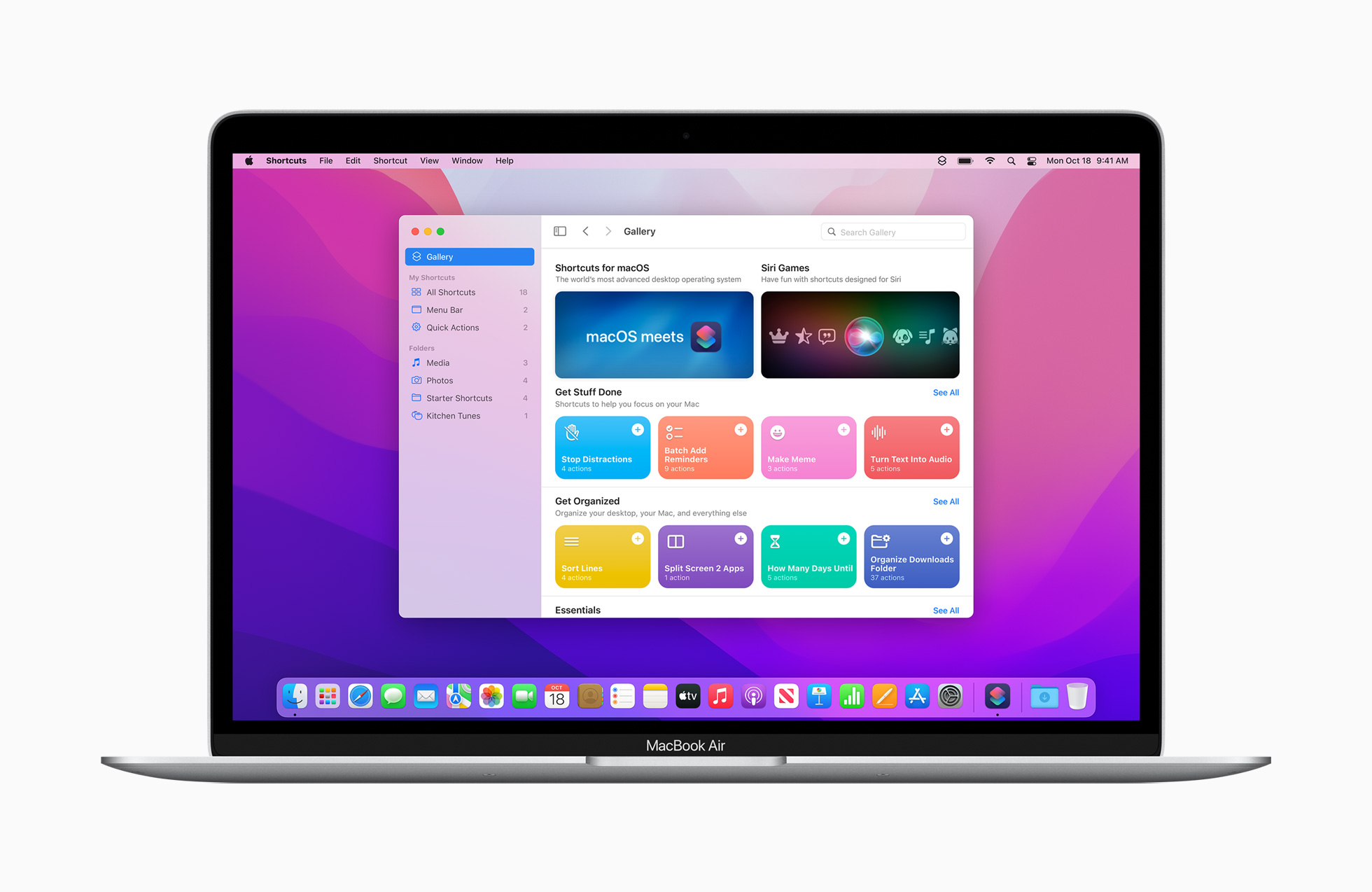
Today, Apple revealed the fully revamped MacBook Pro, powered by the all-new M1 Pro and M1 Max – the first pro chips explicitly created for the Mac. If you missed the event, here's a rundown of everything Apple said
Two Newly Developed In-House Chips
It's been almost a year since Apple announced that it would be ditching Intel chips in favor of its in-house silicon, the M1, which powers both the MacBook Air and the 13-inch MacBook Pro. The M1 is succeeded by not one but two new chips: the M1 Pro and M1 Max.
M1 Pro pushes the pioneering architecture of M1 to new heights. M1 Pro boasts up to 70% faster CPU performance than M1 and up to 2x faster GPU performance, thanks to a powerful up-to-10-core CPU with eight high-performance cores and two high-efficiency cores, as well as an up-to-16-core GPU. M1 Pro also supports up to 32GB of fast unified memory and has a memory bandwidth of up to 200GB/s, roughly three times that of the M1. In addition, M1 Pro includes a ProRes accelerator in the media engine, offering amazingly rapid and power-efficient video processing. It is designed to speed up pro video operations substantially.
M1 Max, the world's most powerful chip for a pro notebook, expands on M1 Pro's incredible capabilities. The M1 Max has the same 10-core solid CPU as the M1 Pro, but it doubles the GPU with up to 32 cores for 4x faster GPU performance than the M1. It also boasts up to 400GB/s of memory bandwidth — twice as much as the M1 Pro and nearly six times as much as the M1 — and up to 64GB of fast unified memory. With even the most recent PC laptops offering up to 16GB of video memory, having this massive amount of memory available is game-changing for professional workloads, allowing professionals to perform things previously impossible on a notebook.
3D artists using the latest MacBook Pro can now work with high geometry and textures in settings that professional PC machines cannot even run. In addition, M1 Max now includes an improved media engine with two ProRes accelerators for even better multi-stream performance. As a result, professionals can edit up to 30 streams of 4K ProRes footage or seven streams of 8K ProRes video in Final Cut Pro, which is more than a 28-core Mac Pro with Afterburner.
New MacBook Pro, Two Sizes
Apple went all-in on the revamp of the MacBook Pro. It is available in 14- and 16-inch chassis, with somewhat bigger screen sizes of 14.2 and 16.2 inches, respectively. Both have a Liquid Retina XDR screen with Apple's Mini LED display technology, which debuted with the 12.9-inch iPad Pro earlier this year. It doesn't generate as deep blacks as OLED screens, such as those seen on Apple's iPhone, but it gets close and retains exceptional brightness levels with vibrant colors.
A notch on top of the screen holds a 1080p camera for video chats, with a larger aperture that allows in more light, so expect better video call performance in low-light environments. However, unlike the iPhone notch, there is no TrueDepth camera system here, which means no support for Face ID.
There is a Touch ID sensor on the keyboard, so you can still use your fingerprint to lock and unlock the MacBook Pro. Unfortunately, Apple also ditched the Touch Bar in favor of physical keys, a shocking acknowledgment that its vision for the expanded digital panel didn't pan out.
The restoration of the ports is undoubtedly the most exciting change to the MacBook Pro. There's an HDMI port, three USB-C connections with Thunderbolt 4, an SD card slot, and a headphone socket with a high impedance. So, by all means, dispose of those ugly dongles. Even better, for the first time since 2017, Apple has reintroduced MagSafe to its MacBooks. It doesn't have an accessory ecosystem like the iPhone 12 and iPhone 13 series, but the charger connects to the dedicated connector magnetically, just like it used to. The USB-C ports are still usable for charging.
Both MacBook Pros include studio-quality microphones and a six-speaker sound system with two tweeters and four woofers for 80 percent greater bass. In terms of battery life, Apple estimates that the 14-inch MacBook Pro has up to 17 hours of video playback time, while the 16-inch variant has up to 21 hours. You may also fast charge these gadgets, gaining up to 50% battery life in just 30 minutes.


The entry-level MacBook Pro (in all sizes) comes with 16 GB of RAM and 512 GB of storage. The 14-inch MacBook Pro costs $1,999, while the 16-inch model costs $2,499 USD. Both variants are presently available for preorder and will be available for purchase on October 26. You have the option of getting the M1 Pro or upgrading to the M1 Max if you require more power. The top-tier option for the 16-inch screen costs a massive $6,099.
Two Newly Developed In-House Chips
It's been almost a year since Apple announced that it would be ditching Intel chips in favor of its in-house silicon, the M1, which powers both the MacBook Air and the 13-inch MacBook Pro. The M1 is succeeded by not one but two new chips: the M1 Pro and M1 Max.
M1 Pro pushes the pioneering architecture of M1 to new heights. M1 Pro boasts up to 70% faster CPU performance than M1 and up to 2x faster GPU performance, thanks to a powerful up-to-10-core CPU with eight high-performance cores and two high-efficiency cores, as well as an up-to-16-core GPU. M1 Pro also supports up to 32GB of fast unified memory and has a memory bandwidth of up to 200GB/s, roughly three times that of the M1. In addition, M1 Pro includes a ProRes accelerator in the media engine, offering amazingly rapid and power-efficient video processing. It is designed to speed up pro video operations substantially.
M1 Max, the world's most powerful chip for a pro notebook, expands on M1 Pro's incredible capabilities. The M1 Max has the same 10-core solid CPU as the M1 Pro, but it doubles the GPU with up to 32 cores for 4x faster GPU performance than the M1. It also boasts up to 400GB/s of memory bandwidth — twice as much as the M1 Pro and nearly six times as much as the M1 — and up to 64GB of fast unified memory. With even the most recent PC laptops offering up to 16GB of video memory, having this massive amount of memory available is game-changing for professional workloads, allowing professionals to perform things previously impossible on a notebook.
3D artists using the latest MacBook Pro can now work with high geometry and textures in settings that professional PC machines cannot even run. In addition, M1 Max now includes an improved media engine with two ProRes accelerators for even better multi-stream performance. As a result, professionals can edit up to 30 streams of 4K ProRes footage or seven streams of 8K ProRes video in Final Cut Pro, which is more than a 28-core Mac Pro with Afterburner.
New MacBook Pro, Two Sizes
Apple went all-in on the revamp of the MacBook Pro. It is available in 14- and 16-inch chassis, with somewhat bigger screen sizes of 14.2 and 16.2 inches, respectively. Both have a Liquid Retina XDR screen with Apple's Mini LED display technology, which debuted with the 12.9-inch iPad Pro earlier this year. It doesn't generate as deep blacks as OLED screens, such as those seen on Apple's iPhone, but it gets close and retains exceptional brightness levels with vibrant colors.
A notch on top of the screen holds a 1080p camera for video chats, with a larger aperture that allows in more light, so expect better video call performance in low-light environments. However, unlike the iPhone notch, there is no TrueDepth camera system here, which means no support for Face ID.
There is a Touch ID sensor on the keyboard, so you can still use your fingerprint to lock and unlock the MacBook Pro. Unfortunately, Apple also ditched the Touch Bar in favor of physical keys, a shocking acknowledgment that its vision for the expanded digital panel didn't pan out.
The restoration of the ports is undoubtedly the most exciting change to the MacBook Pro. There's an HDMI port, three USB-C connections with Thunderbolt 4, an SD card slot, and a headphone socket with a high impedance. So, by all means, dispose of those ugly dongles. Even better, for the first time since 2017, Apple has reintroduced MagSafe to its MacBooks. It doesn't have an accessory ecosystem like the iPhone 12 and iPhone 13 series, but the charger connects to the dedicated connector magnetically, just like it used to. The USB-C ports are still usable for charging.
Both MacBook Pros include studio-quality microphones and a six-speaker sound system with two tweeters and four woofers for 80 percent greater bass. In terms of battery life, Apple estimates that the 14-inch MacBook Pro has up to 17 hours of video playback time, while the 16-inch variant has up to 21 hours. You may also fast charge these gadgets, gaining up to 50% battery life in just 30 minutes.


The entry-level MacBook Pro (in all sizes) comes with 16 GB of RAM and 512 GB of storage. The 14-inch MacBook Pro costs $1,999, while the 16-inch model costs $2,499 USD. Both variants are presently available for preorder and will be available for purchase on October 26. You have the option of getting the M1 Pro or upgrading to the M1 Max if you require more power. The top-tier option for the 16-inch screen costs a massive $6,099.
Apple also revealed in a news statement that MacOS Monterey, the company's latest operating system, will be available for download on October 25.
Read more:
[1] https://www.apple.com/newsroom/2021/10/apple-unveils-game-changing-macbook-pro/



neiplynup
2022-10-25 03:45
ivermectin for sale fig 7d western blot; human; loading